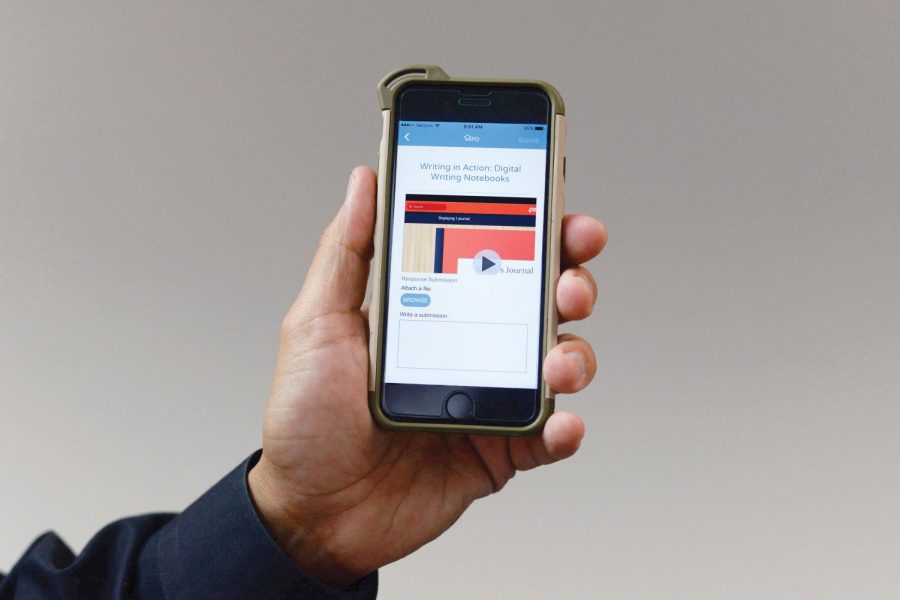Bringing special education to the mobile world
Professor of Instructional Technology at Kent State University, Richard Ferdig, and his team developed several apps to help special education children.
September 20, 2016
A member of Kent State’s faculty has launched a project that developed a website with hundreds of educational mobile apps.
Called SpedApps, the app was launched by Richard Ferdig, a Kent State lifespan development and educational sciences professor, this past spring. The project is meant to deepen the understanding of the current role of mobile education through apps, specifically for special education.
There is a website for the SpedApps program consisting of 530 apps that a teacher or parent can find.
The search field for apps can be narrowed by the needs of the student in a variety of ways, such as subject and disability needs, and refined to reading, math, social-emotional and other needs a student may have.
The website is also focused on the content of every app rather than an app that’s designed for specific disability.
“With students with disabilities, you want to focus on a specific skill rather than a disability,” said Pena Bedesem, a creator of SpedApps as well as a lifespan development and educational sciences associate professor.
A perk of this website is that it allows for the users to review the apps, and even if an app were to have a lower rating than others, it will not be removed from the site.
“What works for one student might not work for others,” Ferdig said. “Also, keeping the lower-rated apps on the sites will allow a parent or teacher to see what apps aren’t good. If someone were to search for an app and we didn’t have it on our site because of the lower rating, they might assume that it’s just such a great app without having seen a review of it.”
Mobile education is defined as learning across multiple platforms, such as phone apps and websites rather than just a classroom setting. It also entails interactive context that can give live feedback and help.
“I’m a huge proponent of mobile education,” Bedesem said. “It uses technology people already have, whereas special education apps used to be costly and (weren’t) available for home use. Now, students can use the same technology at home and at school.”
With the creation process of making an app and understanding what was needed by the audience, with regards to the website, Ferdig was not alone.
“It’s never just one person, it can’t be an island,” he said.
There was a content team and a special education team involved.
First, the special education team looks into the apps being used by students and parents.
Then, Ferdig goes to the content team to find the specific needs that have to be met, such as social-emotional help, reading and math. The content team will then investigate and review the app before putting it on the site.
With apps still in the works and programs being added to the site constantly, Ferdig has great faith in the ever-growing use of mobile learning.
“AT&T and Martha Holden Jennings have been a stronger contributor to our project,” Ferdig said. “There is amazing working being done at Kent that will lead the world in mobile education.”
When asked why he developed or used an app, instead of a program that teachers or parents can buy to help their child, Ferdig said, “It provides easier access for the children.”
He went on to speak about the fact that it is on-the-go, consumable data that will allow for learning anywhere.
“As you look around now, you see that across any socioeconomic status, racial barriers or any type of barrier there are very few things that will keep someone from having access to a device,” he said.
The SpedApps program has also launched its own apps including the National Park app — the National Science Foundation — that can be used in any national park and will buzz when the user is at a point of interest.
Ferdig mentioned that while on a walk with his son in a park, he was asked a question and didn’t know the answer, so he thought: “What would it look like to have some support?” There’s also a yet to be released professional development app in the works.
However, the first app launched Aug. 19, according to the Apple app store, was Number Line Math: Multiplication.
The app is meant to help children that have difficulty with multiplicative reasoning, which is the ability to recognize the pattern within the number line to do multiplication.
Ferdig wanted to see what it was like to teach mobile learning that is going to help people with a multitude of needs. In reference to the Blackboard app, Ferdig wanted to create an app that would allow the student access to something they wouldn’t be able to get on the computer. He wanted something new and innovative.
“We can’t talk about it without doing it ourselves,” Ferdig said.

























